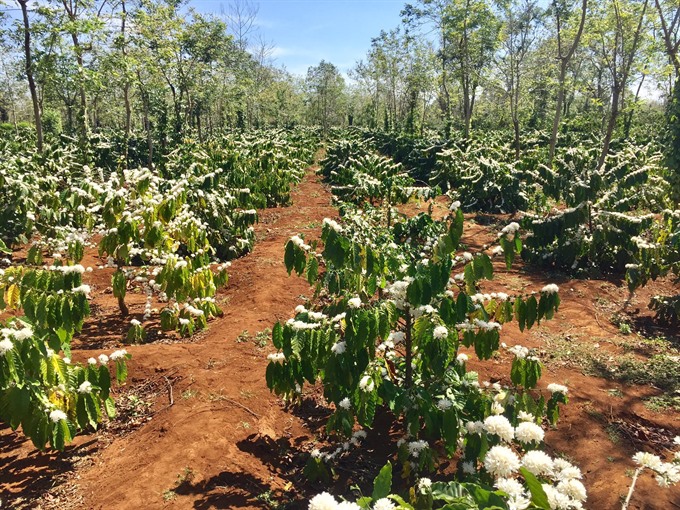 Features
Features

A shortage of capital and lack of technical assistance for farmers in the Central Highlands region are hampering efforts to replace old, unproductive trees on coffee farms. Bồ Xuân Hiệp reports.
 |
| New crop: Many farmers have begun growing pepper plants because their old coffee trees have become unproductive. |
A shortage of capital and lack of technical assistance for farmers in the Central Highlands region are hampering efforts to replace old, unproductive trees on coffee farms. Bồ Xuân Hiệp reports.
Walking through his farm in the Central Highlands province of Đắk Lắk, Y Drăn Byă could not hide his anxiety about the urgent need to replace his coffee trees, many of them nearly 50 years old.
Ten years ago, Byă saw high profits from his coffee farm, but in recent years the crop’s yields and quality have declined sharply.
“The yields have fallen to only 1.3-1.5 tonnes per hectare a year, compared to five to seven tonnes a decade ago,” he said. “Climate change has also affected the yields.”
More than 60 per cent of his coffee trees, on about one hectare in Êa Tu Commune, were planted in 1972.
Despite declining profits, Byă, 51, of the Êđê ethnic group, said he had been reluctant to take part in a government programme begun in 2012 to replant old coffee trees in the region.
“I don’t have access to bank loans,” Byă said. “My family’s income relies heavily on coffee cultivation, and it would take three years to harvest beans from new trees.”
Byă is only one of thousands of farmers in the commune facing a lack of capital and technical assistance in a region that is critical to Việt Nam’s coffee industry.
Of the 622,000 hectares of coffee trees in the country, the Central Highlands region accounts for nearly 95 per cent of the area and 99 per cent of output, according to the Ministry of Agriculture and Rural Development.
However, the number of farms with old or stunted coffee trees is increasing, resulting in lower yields.
Nguyễn Bá Thanh, Party secretary of KoTam Village in Êa Tu Commune, said the village has 600 households with 3,000 people, with 500 households growing coffee trees and the rest cultivating rubber trees.
Farmer Y Nguê Mlô said that most farmers in KoTam Village grow coffee, but yields had been only 1-1.5 tonnes per hectare a year in recent years.
Another farmer in the village, Y Bang Nie Hrah, said to increase coffee yields, many farmers had intercropped coffee trees with other trees like durian, avocado and pepper.
 |
| Hope springs afresh: A new coffee farm expected to produce high yields in Êa Tu Commune in Buôn Ma Thuột, considered the main coffee metropolis of Việt Nam. VNS Photos Bồ Xuân Hiệp |
Due to a lack of capital, “we have had to ask for a delay in payments for fertiliser to agents until we harvest the coffee,” he said.
Nguyễn Thị Châu said a great number of coffee farmers, many of them female, were working as manual workers in different places in the province as they could not rely on earnings from coffee.
Hoăn Mlô, former chairman of Êa Tu Commune, said that in addition to aging coffee trees, the quality of the soil had degraded, affecting yields and quality of coffee trees.
Most farmers, who have difficulty accessing bank loans as they have no collateral, still cannot pay back previous bank loans.
“So, many families have decided to let their sons and daughters study foreign languages so they can work abroad,” Mlô said.
The commune, with a population of 16,000, is a major coffee farming area covering 1,500 ha in Buôn Ma Thuột.
Replantation plan
Đắk Lắk Province has set a goal to replace 85,000ha of old coffee trees in the next five to 10 years, according to Nguyễn Hữu Vương, chairman of the People’s Committee of Êa Tu Commune.
Besides more capital, farmers need high-quality seedlings, which will be selected by the Central Highlands’ Agro-Forestry Scientific and Technical Institute.
Vương said the commune authorities would also work closely with commercial banks to provide farmers better access to bank loans.
Huỳnh Quốc Thích, deputy director of Đắk Lắk’s Department of Agriculture and Rural Development, said that farmers would be able to replace old and stunted coffee trees under a project developed by Nestle Việt Nam.
Nestle Việt Nam will pay half of the farmers’costs for new seedlings.
“The project has also accelerated the purchase of new coffee varieties with yields of up to seven tonnes per hectare, almost double the current average,” Thích said.
Besides providing disease-free and high-quality seedlings, the project offers farmers technical assistance to meet the international 4C (Common Code for Coffee Community) standards for sustainable production and trading.
The number of coffee growers certified under 4C standards increased from 1,745 in 2011, when the programme started, to more than 13,800 last year.
According to Thích coffee trees have been cultivated in Đắk Lắk for at least 100 years. Most of the trees are more than 20 years old and produce low yields as the average life span for coffee trees is between 20 and 30 years.
The industry is facing other problems such as small-scale production, poor quality control, and outdated processing technologies.
Coffee trees more than 20 years old account for 23 per cent of the cultivated area, and trees 15-20 years old nearly 35 per cent.
More than 92 per cent of the coffee trees have not adapted well to disease or to climate change.
 |
| Tough going: A farmer in Êa Tu Commune in Đắk Lắk Province speaks about the challenges facing coffee farmers at a recent meeting with local authorities and representatives of Vinacafé Biên Hoà Joint-Stock Company. |
In addition, intensive farming and improper use of fertilisers as well as pesticides have seriously affected soil quality in the province. Many farmers often water trees excessively, washing away nutrients needed for the plants.
The Central Highlands region needs to replace old trees on a total of 200,000 ha in the next five to 10 years, according to the Ministry of Agriculture and Rural Development.
Đắk Lắk needs to replace 85,000ha of old trees; Lâm Đồng, 59,000ha; Gia Lai, 27,000ha; and Đắk Nông, 24,000ha.
Strategic agreement
Besides the government programme begun in 2012 to replace old trees, support from private companies is expected to help revive the coffee industry.
During the sixth biennial Buôn Ma Thuột Coffee Festival, a strategic agreement between two companies was signed to develop the Buôn Ma Thuột coffee brand.
The agreement between Bình Điền Fertilizer Joint-Stock Company and Vinacafé Biên Hòa Joint-Stock Company, a member of the Masan Group Corp, aims to help farmers replace old and stunted coffee trees.
It is also expected to help local authorities create a high-quality, high-yield coffee area in Êa Tu Commune.
Under the programme, cutting-edge technologies will be used in pilot production models, while small farming households will merge into larger farming areas to improve coffee yields.
The two companies said they would work with the province’s Department of Agriculture and Rural Development as well as its Agriculture Extension Centre.
To improve the Buôn Ma Thuột coffee brand, the two firms are now working with the Central Highlands’ Agro-Forestry Scientific and Technical Institute to create linkages among farmers, scientists, businesses and the state.
Nguyễn Tấn Kỷ, general director of Vinacafé Biên Hoà, said the programme would be expanded to other areas in the province if the pilot model was successful.
Buôn Ma Thuột City is considered the major coffee metropolis of Việt Nam.
Gov’t support
Besides Đắk Lắk, Đắk Nông Province is another important coffee-producing area in Central Highlands.
Most of the farmers in Đắk Nông have also been taking part in the government’s coffee replantation programme which began in 2012.
In addition to training courses, farmers learn about the quality of seed strains and fertilisers and how to ensure sustainable cultivation of coffee trees.
As part of a new programme effort, the buds from old, but still good, coffee trees will be grafted on to other trees to increase yields.
Đắk Nông has more than 125,000 ha of coffee. Of the total area, commercial coffee farms account for 113,000ha, according to the department.
As of the end of last year, the area of new coffee trees had expanded by 8,000ha since 2012.
 |
| This has to go: Y Drăn Byă, 51, of Êa Tu Commune in the Central Highlands province of Đắk Lắk, says that his old, unproductive coffee trees need to be replaced with new trees. |
Of that number, farmers invested in 4,450ha, while the local government provided funds for saplings for the remaining area.
Nguyễn Văn Chương, deputy director of the province’s sub-department of plant protection, said many new coffee farms had harvested high yields under the programme.
But he said the programme had been carried out too slowly.
Along with the lack of seedlings, farmers still find it difficult to borrow money from local banks.
As of last month, farmers in the programme had received a total of only VNĐ38 billion ($1.7 million) from the Đắk Nông branch of the Việt Nam Agriculture and Rural Development Bank.
To help them access loans, the province plans to simplify paperwork procedures.
Coffee was introduced to the Central Highlands region by the French in 1857.
With ideal growing conditions, coffee beans from Buôn Ma Thuột gained a reputation for superior characteristics.
The Central Highlands benefits from basalt soil and is 500 metres above sea level, a climate suited to growing coffee trees.
In 1997, Việt Nam was the world’s fourth-largest coffee exporter after Brazil, Colombia and Indonesia.
Three years later, Việt Nam became the world’s second largest exporter of coffee beans, a ranking that it retains today. Vietnamese robusta beans account for 70 per cent of robusta traded in the world.
Farmer Byă of Êa Tu Commune said he would reconsider taking part in the Government’s programme if he was ensured of sufficient support.
He said he wanted to replace half of the trees on his coffee farm, but would continue to cultivate the remaining half while waiting for further assistance from local authorities.
“My four children have left the farm to work in HCM City,” he said. “My wife and I have no choice but to continue to cultivate the old trees we have. So, I hope to receive further financial and technical support from the Government to replace my old trees soon.” — VNS




